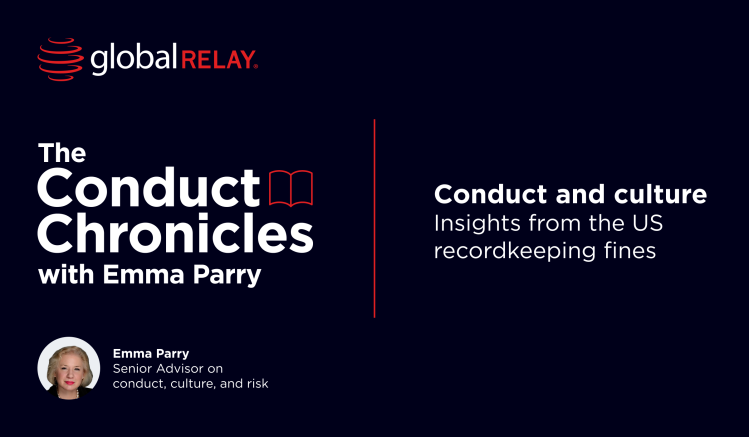
The Conduct Chronicles – Conduct and Culture: Insights from the US Record Keeping fines
Culture is determined by more than just 'tone from the top', it requires ongoing effort and investment. Firms should also look to celebrate good behavior, and ensure incidents of bad behavior are being escalated.
Written by a human
Tone from the Top
Hot on the heels of the staggering tsunami of US SEC and CFTC record keeping fines, came public statements by the regulators denouncing the poor conduct and culture they had uncovered. In its August 2023 statement, the CFTC admonished firms for the significant failings, stating that:
‘The CFTC found significant unauthorized communication practices involving those at a senior level. The conduct found serves as a red flag about bank culture.’
Moreover, alongside its impatience with the widespread misconduct it had uncovered, the CFTC stated that the record keeping failures amounted to evasion:
‘Tone at the top dictates a bank’s culture and that tone must change on Wall Street and large foreign banks. The tone at the top the CFTC found was one of evasion, keeping regulators in the dark. Change can only happen if the bank’s C-suite establishes a culture of compliance over evasion. It is far past time for the C-suite to step up.’
The recognition of the importance of ‘Tone from the Top’ is not new. So, what’s gone wrong? And why is the CFTC, amongst other regulators, uncovering this magnitude of wrongdoing?
Let’s first consider what other regulators have been focused upon, their approach to conduct and culture, and what they have discovered (so far).
The Dutch National Bank
At the forefront of understanding and assessing conduct and culture is the Dutch National Bank’s (DNB). Since 2011, it has explicitly supervised and assessed behavior and culture at the institutions for which it is responsible. Its aim is to better understand two key aspects:
- The influence of individual actions and group dynamics on financial performance, risk and integrity. In this regard, the DNB is keen to understand how the prevailing culture facilitates desirable behavior and restrains undesirable behavior
- The measures needed to mitigate the risks related to human behavior.
Key to the DNB’s methodology is onsite inspections including observing board meetings in action.
Its culture assessments cover:
- Board effectiveness and dynamics including onsite observation of the board , its decision-making, leadership, communications and the group dynamics
- Risk culture which focuses on understanding any behavioral factors that have a ‘detrimental impact’ on risk management
- Change effectiveness which is focused on whether firms are able to implement organizational and cultural change programs
- Root cause analysis which ascertains whether there are underlying behavioral and cultural explanations for a firm’s persistent problems
Interestingly, one of the DNB’s core, and initial findings, was that ‘management boards did not generally have sufficient expertise in behavior and culture, and there was still too much emphasis on content-based leadership.’
The UK FCA
Meanwhile, in the UK, in 2015, the FCA launched its 5 conduct questions program. In its first three years, its engagement with firms centrered around a forum created to receive progress reports and deliver feedback – the Annual Conduct Meeting (ACM). ACMs typically involved top management executives at the firm. However, over time, the FCA broadened its engagement to include global business and support services heads.
Whilst acknowledging the importance of ‘Tone from the Top’, what the FCA uncovered in the later years of the program speaks to some of the challenges that continue to persist in the industry today. Specifically, in its 2019 / 2020 report the FCA stated that it found that ‘speaking-up is sometimes still unsafe’ and that whilst whistleblowing channels exist ‘participants described them as largely unused and reserved for the most serious cases.’
What we can infer from this finding is that, even if personnel undercover control gaps or indeed flagrant breaking of rules (eg. off-channel communications for business use), they may not feel uncomfortable to escalate it. This, in turn, means that misconduct or critical issues may remain undisclosed for significant periods of time. And indeed, this is what the record keeping fines highlighted – historical misconduct, over multiple years.
And, if as uncovered by the DNB, we have boards that have insufficient expertise in behavior and culture, alongside cultures where personnel feel intimidated about speaking up, then it’s little wonder that regulators around the world are redoubling their focus on culture and its impact on conduct outcomes.
However, a light touch regulatory approach that relies on firms simply responding to a demand for ‘tone from the top’ is unlikely to work. Those regulators who get in front of CEOs and senior managers, and who also speak with personnel across various levels of seniority, will have more success in understanding the status quo and ultimately in helping to drive industry and cultural change. And that, is what firms should be expecting …
Back to Basics
With global regulators’ inevitable (re)pivot back to culture, firms should be considering these three basic questions.
To what extent are you:
- Speaking about conduct and culture (eg. in team meetings, Town Halls)? While it can be tempting to focus solely on bad behavior and fines, it’s important to highlight examples of good behavior. Are you celebrating role models from across the business and the customer success stories that have resulted from – for example – drawing together a diverse team to ensure that the solution truly met the client’s needs?
- ‘Walking the floor’ and observing your firm’s culture in action? Of course, if your firm has working from home as an option, have you ensured that remote ‘walking the floor’ processes exist?
- Ensuring that you are capturing and analyzing the right data? This goes beyond ensuring that the data and information is complete and accurate, but importantly, that incidents are being escalated and that an audit trail exists of how these issues are being resolved?
Culture is not static
Managing culture is not a one-off event, it requires a continuous and ongoing effort, with firms needing to find ways to keep culture discussions insightful, relevant and thought-provoking.
Crucially, culture is not static. Every misdemeanor that goes unpunished, and every client success that goes uncelebrated, goes towards the building of a firm’s future culture.
Culture is precious. It must be nurtured, applauded and cherished.



